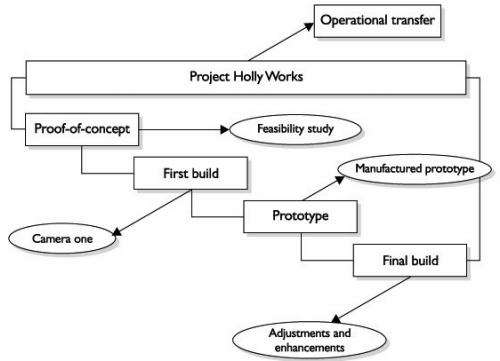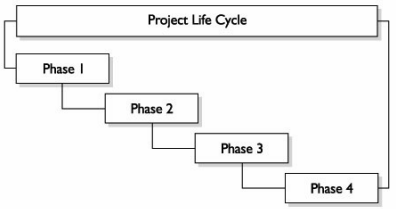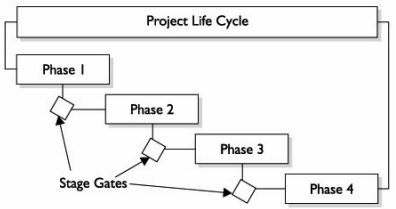Version [18208]
Dies ist eine alte Version von PmLifeCyrcle erstellt von RonnyGertler am 2012-12-12 17:02:19.

Project Life Cyrcle
Inhalte von Prof. Dr. Kurt Englmeier
Consider any project, and you'll also have to consider any phases within the project. Construction projects have definite phases. IT-projects have definite phases. Marketing, sales, and internal projects all have definite phases. Projects - all projects - are comprised of phases. The sum of a project's phases equates to the project's life cycle. Project integration management is the heart of project management and is made up of the day-to-day processes the project manager relies on to ensure that all of the parts of the project work together. PIM gears the project work together.
Project Life Cycle - Example
Because every project life cycle is comprised of phases, it's safe to assume that each phase has a specific type of work that allows the project to move towards the next phase in the project. In a simple construction example, this is easy to see:
Phase 1: Planning and pre-build
Phase 2: Permits and filings
Phase 3: Prep and excavation
Phase 4: Basement and foundation
Phase 5: Framing
Phase 6: Interior
Phase 7: Exterior
Typically, one phase is completed before the next phase begins, but sometimes project managers allow phases to overlap because of time constraints. When time's an issue and a project manager allows one phase to begin before the last phase is completed, it's called fast tracking. Fast tracking, as handy as it is, increases the risk within a project, however.
A project is an uncertain business—the larger the project, the more uncertainty. It's for this reason, among others, that projects are broken down into smaller, more manageable phases. A project phase allows a project manager to see the project as a whole and yet still focus on completing the project one phase at a time.
Each project has its own unique attributes, activities, and requirements from stakeholders. Within each project, one attribute that typically varies from project to project is the project life cycle. As the name implies, the project life cycle determines not only the start of the project, but also when the project should be completed.
Project Feasibility Study
The project's feasibility is part of the initiating process. Once the need has been identified, a feasibility study is called for to determine if the need can realistically be met. The outcome of the feasibility study may tell management several things.
● Whether the concept should be mapped into a project
● If the project concept is worth moving forward with
● The expected cost and time needed to complete the concept
● The benefits and costs to implement the project concept
● A report on the needs of the organization and how the project concept can satisfy these needs
Common Traits of Projects
While projects differ, there are other common traits from project to project. The following lists a few examples:
● Phases are generally sequential, as the completion of one phase allows the next phase to begin.
● Cost and resource requirements are lower at the beginning of a project, but grow as the project progresses. Projects spend the bulk of their budget and
use the most resources during the executing process. Once the project moves into the final closing process, costs and resource requirements taper off dramatically.
● Projects fail at the beginning, not at the end. In other words, the odds of completing are low at launch and high at completion. It also means that decisions made at
the beginning of a project live with the project throughout and that a poor decision in the early phases can cause failure in the later phases.
● The further the project is from completing, the higher the risk and uncertainty. Risk and doubt decrease as the project moves closer to fulfilling the project vision.
● Changes are easier and more likely at the early phases of the project life cycle than at the completion. Stakeholders can have a greater influence on the outcome of the project deliverables in the early phases, but in the final phases of the project life cycle, their influence on change diminishes. Thankfully changes at the beginning of the project generally cost less and have lower risk than changes at the end of a project.

The Project Life Cycle in Action
You're the project manager for HollyWorks Productions. Your company would like to create a new video camera that allows consumers to make video productions that can be transferred to different media types, such as VHS, DVDs, and PCs. The video camera must be small, light, and affordable. This project life cycle has several phases from concept to completion.
1) Proof-of-concept
In this phase, you'll work with business analysts, electrical engineers, customers, and manufacturing experts to confirm that such a camera is feasible to make. You'll examine the projected costs and resources required to make such a camera. If things go well, management may even front you some cash to build a prototype.
2) First build Management
loves the positive information you've discovered in the proof-of-concept phase—they've set a budget for your project to continue into development. Now you'll lead your project team through the process of designing and building a video camera according to the specifications from the stakeholders
and management. Once the camera is built, your team will test, document, and adjust your camera for usability and feature-support.
3) Prototype manufacturing
Things are going remarkably well with your video camera project. The project stakeholders loved the first build and have made some refinements to the design. Your
project team builds a working model, thereby moving into prototyping the video camera's manufacture and testing its cost-effectiveness and ease of mass production. The vision of the project is becoming a reality.
4) Final build
The prototype of the camera went fairly well. The project team has documented any flaws, and adjustments are being made. The project team is also working with the manufacturer to complete the requirements for materials and packaging. The project is nearing completion.
5) Operational transfer
The project is complete. Your team has successfully designed, built, and moved into production a wonderful, affordable video camera. Each phase of the project allowed the camera to move toward completion. As the project came closer and closer to moving into operations, risk and project fluctuation waned.

Project Phase Deliverables
A project is moving from conception to completion. At the end of each phase there is some deliverable that the project manager can show to management and customers.

Stage Gates
Project phase completions are also known as stage gates. Stage gates are used often in manufacturing and product development, and they allow a project to continue after a performance and deliverable review against a set of predefined metrics.

If the deliverables of the phase, or stage, meet the predefined metrics, the project is allowed to continue. Should the deliverables not meet the metrics, the project may not be allowed to pass through the gate to move forward. In these unfortunate cases, the project may be terminated or sent through revisions to meet the predetermined metrics.
Project Stakeholders
Stakeholders are those fine folks and organizations who are actively involved in the project or who will be affected by its outcome—in other words, people, groups, businesses, customers, and communities that have a vested interest in the project.
Stakeholders, especially those not in favor of the project deliverable, may try to influence the project itself.
● Political capital leveraged to change the project deliverable
● Change requests to alter the project deliverable
● Scope addendum to add to the project deliverable
● Sabotage, through physical acts or rumors, gossip, and negative influence
Key Project Stakeholders
Project manager
The project manager is the person that is accountable for managing the project. She guides the team through the project phases to completion.
Program manager
The program manager coordinates the efforts of multiple projects working together in the program. Programs are comprised of projects, so it makes sense that the program manager would be a stakeholder in each of the projects within the program, right?
Portfolio management
Review board Organizations only have so much capital to invest in projects. The portfolio management review board is a collection of the decision makers, usually executives, that review proposed projects and programs for their value and return on investment for the organization.
Functional managers
Most organizations are chopped up by functions or disciplines, such as information technology, sales, marketing, and finance. Functional managers are the managers of the permanent staff in each of these functions. Project managers and functional managers interact on project decisions that affect functions, projects, and operations.
Customer
The customer is the person or group that will use the project deliverable. In some instances, a project may have many different customers. Consider a book publisher for children. The bookstores distribute the children's book. The adults pay for the book. The children read the book. There is also some consideration given to the user versus the customer. The user uses the product; the customer pays for it. A stakeholder can be both a user and a customer.
Operations management
The core business of an organization is supported primarily by operations management. Operations managers deal directly with the income-generating products or services the company provides. Projects often affect the core business, so these managers are stakeholders in the project. Project deliverables that affect the
core business usually include an operational transfer plan that defines support, training, and maintenance on the project deliverables.
Project team
The project team is the collection of individuals that will, hopefully, work together to ensure the success of the project. The project manager works with the project team to guide, schedule, and oversee the project work. The project team completes the project work.
Project management team
These are the folks on the project team who are involved with managing the project.
Project sponsor
The sponsor authorizes the project. This person or group ensures that the project manager has the necessary resources, including monies, to get the work done. The project sponsor is someone within the performing organization who has the power to authorize and sanction the project work, and is ultimately accountable for the project's success.
Sellers and business partners
Organizations often rely on vendors, contractors, and business partners to help projects achieve their objectives. These business partners can affect the project's success, and they are considered stakeholders in the project.
The project management office
If a PMO exists for the organization, it's considered a stakeholder of the project because it supports the project managers and is responsible for the project's success. PMOs typically provide administrative support, training for the project managers, resource management for the project team and project staffing, and centralized communication.
CategoryPmMa
Diese Seite wurde noch nicht kommentiert.





